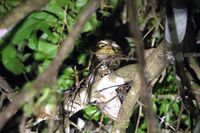| Flores scops owl | |
|---|---|

| |
| Scientific classification | |
| Kingdom Information | |
| Domain | Eukaryota |
| Kingdom | Animalia |
| Subkingdom | Bilateria |
| Branch | Deuterostomia |
| Phylum Information | |
| Phylum | Chordata |
| Sub-phylum | Vertebrata |
| Infraphylum | Gnathostomata |
| Class Information | |
| Superclass | Tetrapoda |
| Class | Aves |
| Sub-class | Neornithes |
| Infra-class | Neoaves |
| Order Information | |
| Order | Strigiformes |
| Family Information | |
| Family | Strigidae |
| Sub-family | Striginae |
| Genus Information | |
| Genus | Otus |
| Species Information | |
| Species | O. alfredi |
| Population statistics | |
| Population | 370-3,800 (2013 est.) |
| Conservation status | Endangered[1] |
the Flores scops owl (Otus alfredi) is a species of owl of the family Strigidae, and found only on the island of Flores in Indonesia. It was named after British naturalist and civil servant Alfred Hart Everett, who collected the type specimens in 1896.
Description[edit]
The Flores scops owl is small, having a body length of 7.3-8.6 inches, and a wing length of 5.25-6.6 inches. The primary color is rufus to reddish brown, without banding or stripes. The facial disk is dark reddish brown, bordered with whitish eyebrows, a forehead marked by fine white wavy lines, and topped by reddish brown ear tufts. Small white patches or spots are present on the base of the back of the neck and on the shoulders. The primaries are reddish brown and white banded. The underside is dirty-white, and occasionally tinged reddish brown. The feet are small in relation to the body size than in other species of scops owls, and the legs are feathered to the toes. The eyes are yellow, the edge of the veil is pink, the beak and the waxy skin are orange-yellow, the toes are dull-yellow and the claws are yellowish horn-colored with no dark tips. The juveniles are almost monochrome bright reddish-brown with indistinct bands, but more pronounced tail-banding than with the adult birds.
The call of the Flores scops owl was first recorded in 2005, and consists of a single, sharp, short "UH" played at intervals of 1.5 to 2.5 seconds. Territorial calls are more common and include a flashy, brief burst of loud, rapid staccato sounds that sound like "UH-UH-UH-UH-UH"[2]. Each phrase contains 5 to 13 tones.
Range and habitat[edit]
The Flores scops owl is restricted in range to the Ruteng and Todo mountains in western Flores, part of the Indonesian archipelago. It inhabits humid forests at elevations above 3,000 feet. Little else is known about them[3].
Threats[edit]
This owl was originally described in 1897 by German naturalist Ernst Johann Otto Hartert, based on the specimens collected by Everett a year earlier in the Todo mountains of southwestern Flores. After no sightings for nearly a century, two birds - a juvenile and an adult - were mist-netted and collected at separate locations in the Ruteng mountains above 3,600 feet elevation. Since then, sporadic sightings have occurred in several areas within their current range, with birdwatchers making contributions to the number. Flores has suffered from a severe reduction of forest due to human activities, resulting in a decline in owl numbers from habitat loss.